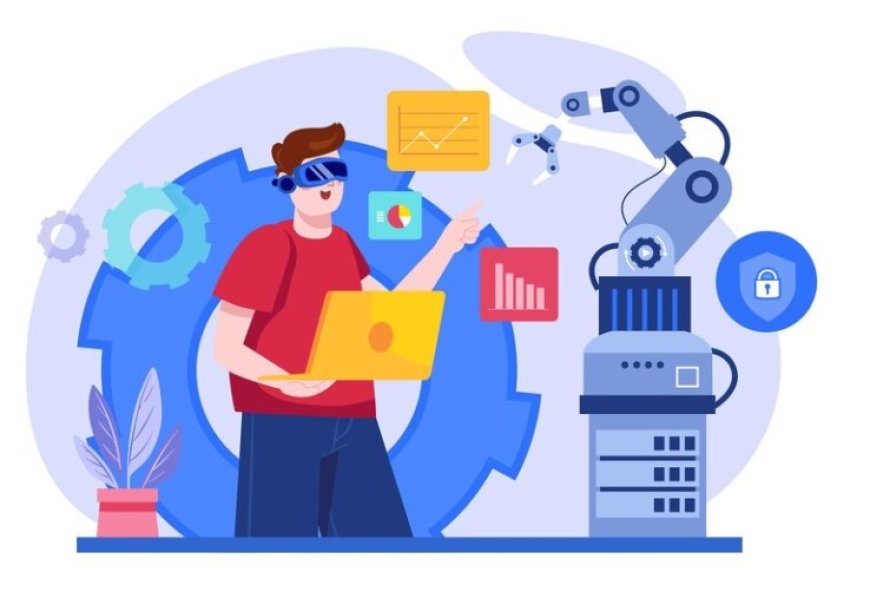Machine Learning's Role in Risk Management
Explore how Machine Learning plays a crucial role in risk management. Learn about ML's impact on identifying and mitigating risks.

Risk management is all about making sure that businesses are prepared for unexpected events that could affect their success. It's like a safety net that helps them deal with challenges. Think of it like wearing a helmet while riding a bike - it keeps you safe if something goes wrong.
This is super important for all kinds of businesses, like banks, hospitals, and even companies that make things. Imagine if a bank didn't have a plan for what to do if there was a big financial problem - it could lead to lots of trouble for them and their customers.
Nowadays, risks are getting more complicated. With all the technology and fast-paced changes, it's not as simple as it used to be. Imagine trying to predict the weather with just a paper and pencil - it's really hard! The same goes for businesses trying to predict what might go wrong.
So, to sum it up, risk management is like a safety plan for businesses, making sure they're ready for any surprises. It's super important for all kinds of companies, and with the world changing so quickly, it's getting even more complex. That's where new tools like machine learning come in to help make sense of it all!
Challenges in traditional risk management methods
Traditional ways of managing risks have some problems. Imagine trying to catch a ball with your eyes closed - it's really hard! Similarly, old methods sometimes struggle to catch all the risks that can happen in a business. They rely on people doing things manually, which can be slow and might miss important details.
Nowadays, businesses face more complicated risks. It's like trying to navigate a maze with lots of twists and turns. Traditional methods might not be equipped to handle these new challenges. They need something smarter and faster.
That's where machine learning comes in. It's like having a super smart assistant that can quickly analyze lots of information. Machine learning uses data to learn and make predictions. It's like a weather app that can tell you if it's going to rain tomorrow. In business, it can help predict things like financial trends or potential problems.
Machine learning makes risk management more efficient. It's like having a high-tech radar that can spot risks from far away. It can process large amounts of data in a short time, something that would take humans much longer. This helps businesses stay on top of things and make better decisions.
So, to sum it up, old ways of dealing with risks can be slow and might miss important details. With today's complicated risks, businesses need something more advanced. That's where machine learning steps in. It's like having a super smart assistant that can quickly spot potential problems. This makes risk management much more effective and helps businesses stay ahead of the game.
How can machine learning be applied to risk management?
Machine learning is like a smart friend who's really good at spotting patterns and making predictions. When it comes to risk management, it can be a game-changer. Here's how it works:
Data Collection and Analysis: Imagine you have a store, and every day, you write down what you sell, how much you spend, and even the weather. Machine learning can help you collect and analyze all this data really fast. It can find hidden connections like, "On rainy days, we sell more umbrellas." This information is gold for managing risks.
Predictive Modeling: Machine learning can predict the future, not in a crystal ball way, but by looking at past data. For your store, it might predict, "Next month, we'll sell more ice cream because it'll be hot." This helps you prepare in advance.
Anomaly Detection: It's like having a guard who watches for strange things. Machine learning can spot unusual stuff, like if someone's using your credit card without you knowing. This is super important for banks and online stores.
Automation: Machine learning can make decisions too. For example, if a company gets lots of orders, it can automatically decide how much of a product to make. This saves time and money.
Benefits and limitations of using machine learning in risk management
Using machine learning in risk management has some great perks, but it's not a superhero with no weaknesses. Let's see both sides:
Benefits:
-
Accuracy: Machine learning is really good at finding patterns and making predictions. This means it can help you make better decisions and avoid risks more effectively.
-
Efficiency: It's super fast at processing lots of data. So, tasks that might take humans a long time can be done in a snap.
-
Real-time Risk Assessment: Machine learning can work 24/7 without getting tired. It can keep an eye on things in real-time and alert you if something's off.
-
Enhanced Fraud Detection: For banks and online stores, machine learning is like a superhero against fraud. It can spot suspicious activities and protect your money.
Limitations:
-
Data Quality and Availability: Machine learning needs good data to work well. If the data is messy or incomplete, it might make mistakes. Plus, not all businesses have access to the data they need.
-
Interpretability: Machine learning can be a bit like a black box. It gives answers, but it can be hard to understand why it made a specific decision. This can be a challenge, especially when you need to explain things to others.
-
Ethical and Regulatory Considerations: Using machine learning in risk management means you need to be careful about fairness and privacy. You can't use it to discriminate against people or invade their privacy.
Specific use cases and industries can benefit from machine learning in risk management
Machine learning can be a helpful friend in many industries. Here are some examples:
-
Banking and Finance: Banks use machine learning to keep an eye on people's accounts. It can spot unusual transactions that might be signs of fraud. So, if someone tries to use your credit card in a different country, the machine learning system might notice it's not your usual spending and send you an alert.
-
Healthcare: In hospitals, machine learning can help doctors make better decisions. It can analyze a patient's data and suggest possible illnesses or treatments. This helps doctors diagnose diseases faster and provide the right treatment.
-
Insurance: Insurance companies can use machine learning to figure out how likely it is that you might have a car accident or a house fire. This helps them set the right prices for your insurance. If you're a careful driver, you'll pay less for car insurance.
-
Supply Chain Management: Companies that make and sell things use machine learning to predict how much of a product they need to make. For example, if a shoe company can predict that red sneakers will be popular in the summer, they'll make more of them to meet the demand.
-
E-commerce: Websites like Amazon use machine learning to recommend products to you. They analyze your past purchases and what other people buy to suggest items you might like. It's like having a personal shopper.
-
Energy and Utilities: Energy companies use machine learning to optimize power generation and distribution. It helps them balance the supply of electricity with the demand, making sure we have power when we need it.
-
Agriculture: Farmers can use machine learning to monitor the health of their crops. It can analyze data from sensors in the fields to detect diseases or pests early. This helps them take action before it's too late.
-
Retail: Stores use machine learning to figure out which products to put on sale or when to offer discounts. It helps them manage inventory and boost sales.
In the end, machine learning is like a new superhero in the world of risk management. It's getting more and more important as businesses face bigger challenges. But it's not meant to replace humans - it works best when it teams up with them. Imagine a human and a robot working together, using their strengths to solve problems.
Finding the right balance between human smarts and machine learning magic is key. Humans bring their experience and understanding, while machine learning brings its super-fast data skills. Together, they make a powerful team. As we look ahead, machine learning has the potential to completely change how risks are managed in different industries. It's like a wave of innovation, bringing better ways to predict and handle all kinds of surprises. So, get ready for a future where machine learning and human expertise join forces to keep businesses safe and successful!


































